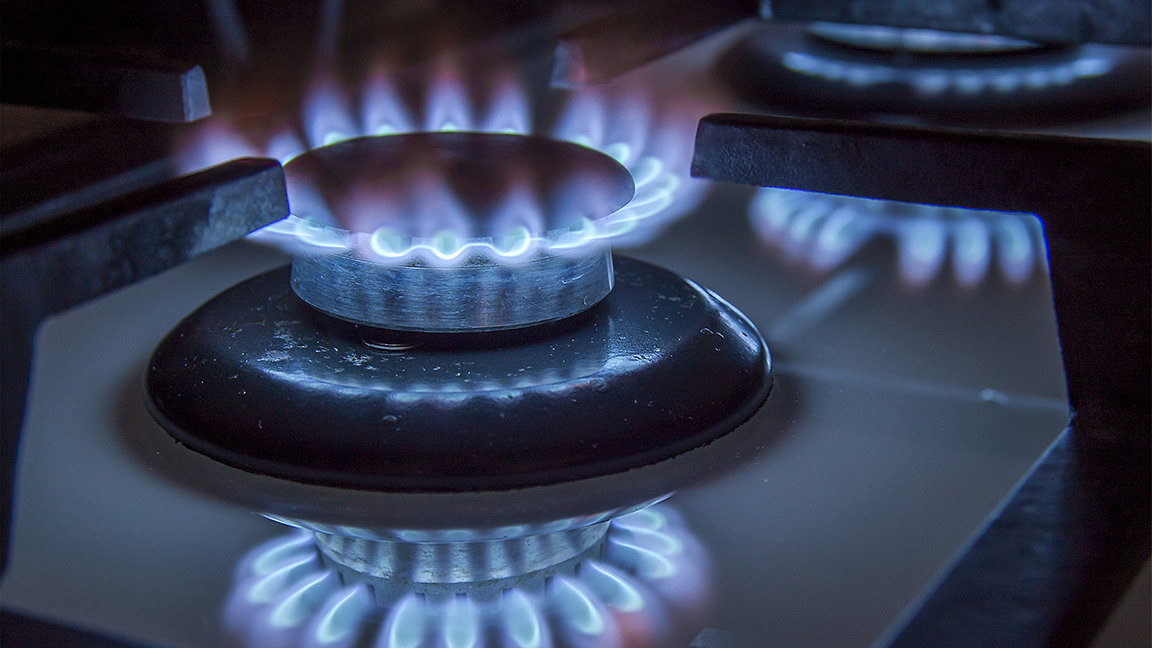
How can we reduce our reliance on fossil fuels while maintaining access to safe, reliable and affordable domestic heating? One proposal is to use existing natural gas infrastructure but introduce hydrogen as an alternative for heating and cooking.
Some 85% of UK homes are connected to the gas network. Many of these homes are heated using natural gas, which is largely made up of methane. During combustion, the methane combines with oxygen from the air to produce energy and carbon dioxide.
Additionally, methane is by itself a highly potent greenhouse gas possessing a global warming potential of between 27 and 30.
Gas differences complicate transition
Making the transition from one gaseous domestic fuel to another has a precedent in the UK. For example, significant quantities of natural gas containing mainly methane were discovered in Yorkshire in 1965 and were then supplied to consumers.
The gas was not used to make manufactured or processed gas – manufactured gaseous fuels are products of processing coal and petroleum, they can be stored and used for both domestic and industrial purposes.
As natural gas combusts in a very different way to manufactured gas, appliances across the country had to be adapted or replaced. Similarly, hydrogen has a different combustion air requirement index (CARI) – a measurement of the volume of air required for a gas to combust – to methane.
The two notable differences between methane and hydrogen are that the latter's molecules are much smaller than the former's, while the second is the different way they react when mixed with air.
When hydrogen burns in pure oxygen, the only thing released is water. Air isn't pure oxygen, though, so using hydrogen domestically isn't quite so clean. While doing so would not produce any carbon emissions, burning hydrogen still produces some of the pollutants as natural gas, such as nitrogen oxides including nitrogen dioxide.
Nitrogen oxides are, like carbon dioxide, greenhouse gases that contribute to climate change. Long-term exposure to high levels of nitrogen dioxide can also lead to respiratory harm. While it's possible to manufacture hydrogen boilers in a way that minimises nitrogen oxide emissions, regulations would be needed ensure that this is the default approach.
Envisaging the shift to hydrogen
When the UK's conversion to natural gas began in 1967, there were around 20m domestic gas-fuelled appliances. Since then, the number of gas appliances has increased considerably. More than 22m households are connected to the gas grid, and by 2020 38% of the UK's gas demand was being used for domestic heating.
As with the transition from manufactured to natural gas, domestic appliances are going to need to be adapted or replaced if we are going to run them on hydrogen. However, completing the work in ten years or sooner would be feasible – provided there are sufficient resources.
There would need to be contingency to mitigate any unintended consequences, as well as training, education, logistics, testing, auditing, safety checks and communication, as well as provision for vulnerable people. Each of these considerations are important factors that must be addressed satisfactorily for a transition to domestic hydrogen implementation.
However, new domestic boilers already accommodate a 20% mix of hydrogen with natural gas, and from 2025 gas boilers will be banned from every new build in the UK – all of which will accelerate the transition. This planning enables customers to be aware of the environmental legislation requirements and prepared to adapt to the change.
As a demonstration to the use of 100% hydrogen for domestic fuels, the construction of a pair of Gateshead-based semi-detached properties was started in 2021 and these houses will become the UK's first homes to fuel household gas appliances entirely using hydrogen. Open to the public and running for three years, this initiative demonstrates the feasibility of hydrogen as a domestic fuel on a small scale and aims to build public trust in the technology.
On a larger scale, a village of 2,000 homes will swap from natural gas to hydrogen in 2025. This pilot project, the first of its kind in the UK, will be an opportunity to learn best practice, but also identify challenges and barriers.
Generating sufficient fuel cleanly
If, and when, these problems are addressed – and assuming hydrogen can be supplied using the existing network – hydrogen boilers could be a low-cost option with minimal disruption for many households. However, the availability of hydrogen itself may become the largest barrier.
A complete rollout of hydrogen gas as a replacement fuel for natural gas would require around 10m tonnes of hydrogen. To be sustainable, this hydrogen would have to be generated using a renewable resource.
Production on this scale could not rely on blue hydrogen, which is made from methane and is thus not a sustainable route for our low-carbon future. Nonetheless, this is currently considered a way of enabling the transition to green hydrogen.
More renewable energy capacity would be needed to produce green hydrogen, which would mean building more wind and solar farms. But these too have associated greenhouse gas emissions in the form of embodied carbon – as does their construction – while electrical installations require the use of potent global warming gas sulphur hexafluoride as this substance is required for high-voltage circuit breakers.
As a domestic fuel, hydrogen remains an attractive option, and it is tempting to see it as a panacea for a low-carbon future. However, it is still far from being a tried and tested solution. All other options must be on the table.
'As a domestic fuel, hydrogen remains an attractive option, and it is tempting to see it as a panacea for a low-carbon future'
Dr Torill Bigg is chief carbon reduction engineer at Tunley Environmental
Contact Tunley Environmental: Email
Related competencies include: Energy and renewable resources, Housing maintenance, repairs and improvements, Housing management and policy

RICS champions sustainability across professions
With the built environment estimated to be responsible for around 40% of global carbon emissions, RICS is championing sustainable practices across the built and natural environment. We are also empowering professionals to embed sustainability considerations into the way they work and better measure environmental impacts.


